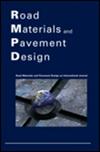Cyclic double punch test as a novel approach to reduce variation in concrete fatigue test results
IF 3
3区 工程技术
Q2 CONSTRUCTION & BUILDING TECHNOLOGY
引用次数: 0
Abstract
AbstractThe large scatter of concrete fatigue test results, commonly associated with the variation in concrete strength measurements, is an issue for performance measurements and design. In this study, considering the decreased variations reported for the monotonic Double Punch Test (DPT) in the literature, an experimental study was conducted to see whether DPT can be used to reduce the variation in concrete fatigue tests. For this, monotonic and cyclic 4-point bending test(4PBT)s, as well as DPTs were conducted, and the variations of the test results were compared by doing statistical analyses. The novelty of this study is the employment of DPT to measure the fatigue performance of concrete. Based on the results, cyclic DPT was found to be a promising technique for fatigue performance measurements with its decreased variation compared to the cyclic bending test. The authors believe that the presented paper will be beneficial for the following studies focused on the cyclic loading performance of concrete.KEYWORDS: concretefatiguecyclic loadingdouble punch testbending testvariation AcknowledgementsThe authors are grateful to Akcansa Cement Industry and Trade Inc., Bogazici Concrete Industry Trade Inc. and SIKA Construction Chemicals Inc. for material supply. The first author would also like to acknowledge the financial support given by The Scientific and Technological Research Council of Turkey (TUBITAK) during his Ph.D. study.Disclosure statementNo potential conflict of interest was reported by the author(s).循环双冲试验是减少混凝土疲劳试验结果变化的新方法
摘要混凝土疲劳试验结果的大离散性,通常与混凝土强度测量的变化有关,是性能测量和设计的一个问题。考虑到文献中单调双冲试验(monotonic Double Punch Test, DPT)的变化幅度减小,本研究对单调双冲试验(monotonic Double Punch Test, DPT)是否可以减小混凝土疲劳试验的变化幅度进行了试验研究。为此,进行了单调和循环四点弯曲试验(4PBT)以及DPTs,并对试验结果的变化进行了统计分析。本研究的新颖之处在于采用DPT测量混凝土的疲劳性能。结果表明,与循环弯曲试验相比,循环DPT试验的变化较小,是一种很有前途的疲劳性能测量技术。笔者认为,本文的研究对今后混凝土循环加载性能的研究具有一定的参考价值。关键词:混凝土疲劳循环荷载双冲压试验弯曲试验变化致谢感谢Akcansa水泥工业贸易公司、Bogazici混凝土工业贸易公司和SIKA建筑化学品公司提供材料。第一作者还要感谢土耳其科学技术研究理事会(TUBITAK)在其博士学习期间给予的经济支持。披露声明作者未报告潜在的利益冲突。
本文章由计算机程序翻译,如有差异,请以英文原文为准。
求助全文
约1分钟内获得全文
求助全文
来源期刊

Road Materials and Pavement Design
工程技术-材料科学:综合
CiteScore
8.10
自引率
8.10%
发文量
105
审稿时长
3 months
期刊介绍:
The international journal Road Materials and Pavement Design welcomes contributions on mechanical, thermal, chemical and/or physical properties and characteristics of bitumens, additives, bituminous mixes, asphalt concrete, cement concrete, unbound granular materials, soils, geo-composites, new and innovative materials, as well as mix design, soil stabilization, and environmental aspects of handling and re-use of road materials.
The Journal also intends to offer a platform for the publication of research of immediate interest regarding design and modeling of pavement behavior and performance, structural evaluation, stress, strain and thermal characterization and/or calculation, vehicle/road interaction, climatic effects and numerical and analytical modeling. The different layers of the road, including the soil, are considered. Emerging topics, such as new sensing methods, machine learning, smart materials and smart city pavement infrastructure are also encouraged.
Contributions in the areas of airfield pavements and rail track infrastructures as well as new emerging modes of surface transportation are also welcome.
 求助内容:
求助内容: 应助结果提醒方式:
应助结果提醒方式:


